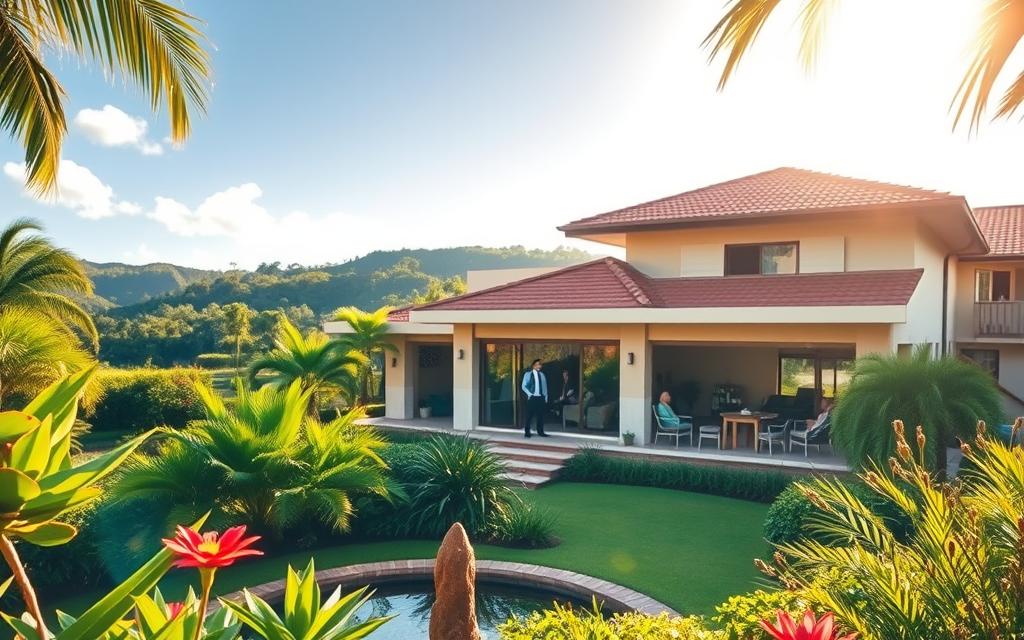
Can You Retire from Lending Money in Costa Rica? Learn More
Costa Rica has become a paradise for retirees, attracting individuals from North America and Europe with its lush landscapes and stable politics. With a reasonable cost of living, it’s no wonder that International Living and Conde Nast Traveler have ranked it as one of the top destinations for retirement living.
For those considering retirement, private lending in Costa Rica offers a unique strategy that combines passive income with the country’s appealing lifestyle benefits. At GAP Investments, we provide tailored financing for private investors, prioritizing safety and risk management to ensure a secure investment environment.
As we explore the potential of private lending for retirement, we’ll examine the benefits and risks, and discuss how this strategy can sustain a comfortable lifestyle in this tropical paradise.
The Potential of Private Lending as a Retirement Strategy
As we explore the potential of private lending in Costa Rica, it becomes clear that this investment strategy offers a unique opportunity for retirees. With years of expertise, we’ve helped many clients succeed in this space, offering loans ranging from $50,000 to over $3,000,000 USD, with competitive interest rates of 12% to 18% annually.
Understanding the Private Lending Market in Costa Rica
The private lending market in Costa Rica is characterized by its size, growth trends, and key players. According to recent data, the average cost of living in Costa Rica, minus rent, totals around $892.90 per month or $10,714.80 a year for an individual retiree. This makes it an attractive option for retirement income. The market operates differently from similar markets in North America and Europe, presenting unique opportunities and considerations.
How Private Lending Differs from Traditional Investments
Private lending in Costa Rica differs significantly from traditional retirement investments like stocks, bonds, and real estate. It offers the potential for higher returns in the Costa Rican market, providing consistent monthly income that aligns well with retirement needs. The economic environment in Costa Rica creates favorable conditions for private lenders, including interest rate differentials and market gaps.
Can You Retire from Lending Money in Costa Rica?
With its pleasant climate and lower living costs, Costa Rica is a popular retirement destination; but can private lending be a reliable source of retirement income? We will explore the potential of private lending in Costa Rica as a retirement strategy, examining whether it can generate sufficient income to support a comfortable retirement lifestyle.
Income Potential from Private Lending
Private lending in Costa Rica can offer attractive returns, potentially supporting your retirement income. For instance, lending $50,000 or more through platforms like GAP Investments can yield returns starting at 12% annually, based on the loan-to-value ratio and other factors. The lower cost of living in Costa Rica means that the income generated from private lending can cover a significant portion of your retirement expenses.
To give you a better idea, let’s consider a few scenarios. If you lend $100,000 at a 12% annual return, you could expect $12,000 per year or approximately $1,000 per month. For larger investments, such as $500,000, the annual return could be $60,000 or $5,000 per month. These figures demonstrate how private lending can contribute substantially to your retirement income.
Realistic Expectations for Returns
While private lending in Costa Rica offers promising returns, it’s essential to have realistic expectations. Returns typically range from 12% to 18% annually, depending on factors such as loan terms, loan-to-value ratios, and borrower profiles. It’s also crucial to understand that private lending involves some level of risk, and returns are not guaranteed.
To mitigate risks, it’s advisable to diversify your investment portfolio and carefully evaluate potential borrowers. Working with a reputable lending platform like GAP Investments can also help in managing risks and ensuring that your investment is secured by tangible assets, such as real estate.
By understanding the income potential and having realistic expectations for returns, you can make informed decisions about using private lending as part of your retirement strategy in Costa Rica.
Benefits of Private Lending in Costa Rica
Private lending in Costa Rica offers numerous benefits for retirees looking to maximize their investment returns. The country’s stable political environment and growing economy create a favorable climate for private lending, offering attractive opportunities for investors.
Competitive Interest Rates
One of the primary benefits of private lending in Costa Rica is the competitive interest rates available. Interest rates range from 12% to 18% annually, based on the loan-to-value (LTV) ratio and other factors, significantly outperforming traditional retirement investments. With fixed terms ranging from six months to three years, private lending provides a predictable income stream for retirees.
Diversification Opportunities
Private lending in Costa Rica also offers diversification opportunities, allowing investors to complement their existing retirement portfolios and reduce overall investment risk. By investing in a different market with lower volatility than many emerging markets, retirees can create a more balanced investment strategy. Costa Rica’s decision to abolish its military in 1948 has fostered a long-standing tradition of peace and democracy, contributing to the country’s appeal as a retirement destination.

Understanding the Risks and Challenges
When considering private lending in Costa Rica as a retirement strategy, it’s crucial to understand the associated risks and challenges. While the potential returns can be attractive, there are several factors to consider to ensure a stable and secure investment.
Market and Economic Considerations
Costa Rica’s economic cycles can significantly impact private lending returns and default rates. During economic downturns, the risk of default may increase, while a growing economy can lead to higher returns. It’s essential to understand these market dynamics to make informed investment decisions.
- Analyze Costa Rica’s economic indicators and forecasts
- Consider the impact of currency fluctuations on your investment
- Assess the overall stability of the Costa Rican financial system
Legal and Regulatory Framework
The legal and regulatory framework governing private lending in Costa Rica is another critical aspect to consider. Understanding the laws and regulations surrounding loan agreements, collateral claims, and enforcement is vital to mitigate potential risks.
Costa Rica offers a well-established legal system that supports private lending, providing a level of stability and security for investors.

Risk Mitigation Strategies
To manage the risks associated with private lending in Costa Rica, several strategies can be employed. Diversification across multiple loans can help spread risk, while proper due diligence processes can identify potential issues early on.
- Diversify your portfolio across multiple loans and borrowers
- Conduct thorough due diligence on potential borrowers and loan terms
- Work with established lending facilitators to leverage their expertise
By understanding the risks and challenges associated with private lending in Costa Rica and implementing effective risk mitigation strategies, you can make more informed investment decisions and work towards a stable retirement income.
Private Lending Investment Options in Costa Rica
As a retiree in Costa Rica, you can explore various private lending investment options to secure your financial future. Costa Rica offers an exceptional healthcare system, known as Caja Costarricense de Seguro Social or “Caja,” which is a significant draw for retirees. Our private lending investments in Costa Rica cater to different investor profiles and retirement income needs.
Real Estate-Backed Loans
Real estate-backed loans are a popular choice among investors. These loans are secured by residential, commercial, or vacation properties in Costa Rica. By leveraging real estate as collateral, investors can enjoy more competitive interest rates, ranging from 12% to 18% annually. For instance, you can invest in real estate-backed loans with loan sizes varying from $50,000 to over $3,000,000.
Business Financing Opportunities
Costa Rica’s growing sectors, such as tourism, agriculture, and technology startups, present lucrative business financing opportunities. By investing in these sectors, you can diversify your portfolio and potentially earn higher returns. Our business financing options are designed to support entrepreneurs and businesses in Costa Rica, offering a range of loan structures and terms.
By exploring these private lending investment options in Costa Rica, you can create a diversified investment portfolio that aligns with your retirement goals. Whether you’re interested in real estate-backed loans or business financing opportunities, our investment options are designed to help you achieve a sustainable retirement income.
How GAP Investments Facilitates Private Lending

GAP Investments is revolutionizing the private lending landscape in Costa Rica. By bridging the gap between foreign lenders and local borrowers, we provide a secure and efficient investment process.
Our team has years of expertise in facilitating private lending opportunities in Costa Rica, understanding the unique needs of foreign and expat investors. We offer tailored financing solutions that cater to their investment goals.
Services for Foreign and Expat Investors
At GAP Investments, we provide a range of services designed to simplify the private lending process for foreign and expat investors. Our services include navigating Costa Rica’s legal and banking systems, handling due diligence, documentation, and loan servicing.
We understand that foreign and expat investors face unique challenges when investing in Costa Rica. Our team is dedicated to providing personalized support, ensuring a smooth investment experience.
Safety and Risk Management Approach
At GAP Investments, safety and risk management are our top priorities. We have a rigorous vetting process for borrowers, thorough collateral evaluation methods, and a robust monitoring system to protect lender interests.
Our approach to safety and risk management includes structuring loans with appropriate legal safeguards. We work closely with lenders to ensure their investment is secure and aligned with their risk tolerance.
Getting Started with Private Lending in Costa Rica
For individuals considering retirement in Costa Rica, private lending can provide a steady income stream, but it’s crucial to get started correctly. We will guide you through the initial steps, from understanding the required capital to setting up your investment structure.
Required Capital and Investment Minimums
Private lending in Costa Rica typically requires a minimum investment of $50,000. This threshold allows you to lend to various borrowers, diversifying your portfolio. When determining your investment amount, consider your retirement goals and the income you wish to generate. GAP Investments can help you navigate the process and identify the right investment opportunities for your needs.
Setting Up Your Investment Structure
To start lending, you’ll need to establish a banking relationship in Costa Rica. This involves opening a local bank account and transferring funds into it. You may also need to provide documentation, such as identification, proof of funds, and investment declarations. We can assist you in understanding the specific requirements and setting up an appropriate investment structure, whether it’s through direct lending, investment vehicles, or managed accounts.

Legal Considerations for Foreign Lenders
The legal environment for foreign lenders in Costa Rica involves several key factors that must be considered to ensure compliance and optimize investment structures.
Tax Implications for Foreign Investors
Foreign investors earning interest income in Costa Rica are subject to withholding taxes and have specific reporting obligations. The tax implications can be significant, and understanding these is crucial for optimizing returns. For instance, Costa Rica has tax treaties with several countries that can affect the taxation of lending income for foreign investors. We recommend consulting with a tax professional to navigate these complexities and ensure compliance with all tax regulations.
Some key considerations include:
- The rate of withholding tax on interest income
- Reporting requirements for tax authorities in Costa Rica and the investor’s home country
- Potential benefits from tax treaties between Costa Rica and other nations
Residency Options for Investor-Retirees
For foreign lenders who wish to reside in Costa Rica, there are several residency options available, including the Pensionado, Rentista, and Inversionista programs. Each program has its own set of requirements and benefits. For example, these programs require a $250 application fee, plus additional costs for document authentication, translation, and notarization. Renewal of program status every two years costs $100, and applicants must provide income information and documents each time. After three consecutive renewals, applicants can apply for permanent resident status.
When structuring lending activities, it’s also important to consider the legal structure used, whether personal, corporate, or through a trust, as this can affect tax treatment and legal protections in Costa Rica. For more information on managing loan terms, visit GAP Investments.
Creating a Sustainable Retirement Income Through Lending
With the cost of living in Costa Rica being significantly lower than in the U.S., retirees can maximize their savings through strategic private lending. We will explore strategies for creating a sustainable retirement income through private lending in Costa Rica that can last throughout your retirement years.
Building a Diversified Lending Portfolio
To achieve a stable retirement income, it’s crucial to build a diversified lending portfolio across different loan types, terms, and borrower profiles. This diversification helps create income stability and reduces reliance on a single investment. By staggering loan maturities, retirees can ensure consistent cash flow and reinvestment opportunities throughout their retirement.
Balancing Risk and Return for Long-Term Stability
Balancing risk and return is vital in a lending portfolio, especially as retirement progresses and risk tolerance may change. We will analyze how to adjust the lending strategy to maintain long-term stability. Integrating private lending income with other retirement income sources, such as pensions, Social Security, and traditional investments, can further enhance financial security.
Conclusion: Is Private Lending in Costa Rica Right for Your Retirement?
Costa Rica’s private lending market offers a unique opportunity for retirees to generate income, but it’s crucial to understand the associated risks and benefits. To determine if private lending is right for your retirement, consider your personal financial goals, risk tolerance, and the overall investment landscape.
With careful planning and the right financial strategy, private lending in Costa Rica can provide a sustainable retirement income. GAP Investments can facilitate your investment journey, offering services tailored to foreign and expat investors. For more information on private lending opportunities in Costa Rica, you can contact GAP Investments at www.gapinvestments.com or via phone/WhatsApp at +(506) 4001-6413.
By understanding the potential returns, risks, and practical steps involved, you can make an informed decision about whether private lending in Costa Rica aligns with your retirement goals.
Article by Glenn Tellier (Founder of CRIE and Grupo Gap)
